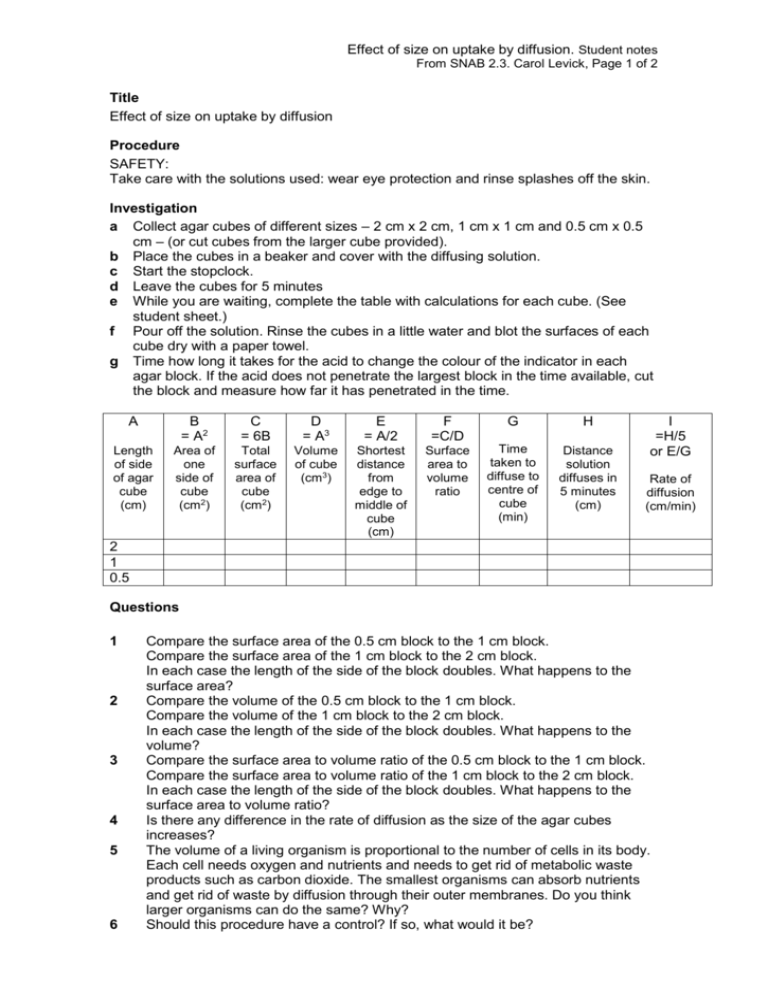Effect of size on uptake by diffusion
advertisement

Effect of size on uptake by diffusion. Student notes From SNAB 2.3. Carol Levick, Page 1 of 2 Title Effect of size on uptake by diffusion Procedure SAFETY: Take care with the solutions used: wear eye protection and rinse splashes off the skin. Investigation a Collect agar cubes of different sizes – 2 cm x 2 cm, 1 cm x 1 cm and 0.5 cm x 0.5 cm – (or cut cubes from the larger cube provided). b Place the cubes in a beaker and cover with the diffusing solution. c Start the stopclock. d Leave the cubes for 5 minutes e While you are waiting, complete the table with calculations for each cube. (See student sheet.) f Pour off the solution. Rinse the cubes in a little water and blot the surfaces of each cube dry with a paper towel. g Time how long it takes for the acid to change the colour of the indicator in each agar block. If the acid does not penetrate the largest block in the time available, cut the block and measure how far it has penetrated in the time. A B = A2 C = 6B D = A3 E = A/2 F =C/D G H Length of side of agar cube (cm) Area of one side of cube (cm2) Total surface area of cube (cm2) Volume of cube (cm3) Shortest distance from edge to middle of cube (cm) Surface area to volume ratio Time taken to diffuse to centre of cube (min) Distance solution diffuses in 5 minutes (cm) I =H/5 or E/G Rate of diffusion (cm/min) 2 1 0.5 Questions 1 2 3 4 5 6 Compare the surface area of the 0.5 cm block to the 1 cm block. Compare the surface area of the 1 cm block to the 2 cm block. In each case the length of the side of the block doubles. What happens to the surface area? Compare the volume of the 0.5 cm block to the 1 cm block. Compare the volume of the 1 cm block to the 2 cm block. In each case the length of the side of the block doubles. What happens to the volume? Compare the surface area to volume ratio of the 0.5 cm block to the 1 cm block. Compare the surface area to volume ratio of the 1 cm block to the 2 cm block. In each case the length of the side of the block doubles. What happens to the surface area to volume ratio? Is there any difference in the rate of diffusion as the size of the agar cubes increases? The volume of a living organism is proportional to the number of cells in its body. Each cell needs oxygen and nutrients and needs to get rid of metabolic waste products such as carbon dioxide. The smallest organisms can absorb nutrients and get rid of waste by diffusion through their outer membranes. Do you think larger organisms can do the same? Why? Should this procedure have a control? If so, what would it be? Effect of size on uptake by diffusion. Student notes From SNAB 2.3. Carol Levick, Page 2 of 2 Answers 1 As length doubles, surface area multiplies by 4. 2 As length doubles, volume multiplies by 8. 3 As length doubles, the surface area to volume ratio halves. 4 The rate of diffusion is the same for each cube. 5 Larger organisms would not be able to get all the nutrients they need, or get rid of all their waste products by diffusion as there is not enough surface area for each cell. The rate of diffusion cannot be increased so this will limit the size of the organism unless it has specialised gas exchange surfaces or other mechanisms. 6 Any sensible suggestion – leave a cube in water, or on a piece of filter paper so you can be sure the change in indicator is due to diffusion of the surrounding solution inwards, not the effect of time on the cubes.











